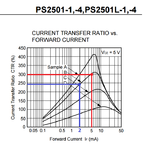T
treez
Guest

Hello,
I am wondering what is the actual spread of CTR for the PS2501-1-K-A optocoupler, when considered over all the LED currents?
Page 6 of the datasheet says its CTR = 300-600%.
Then the graph on top right of page 8 shows CTR vs diode current, but does not say which opto family each graph corresponds to. Do you know?
PS2501-1-K-A optocoupler datasheet:-
**broken link removed**
I am wondering what is the actual spread of CTR for the PS2501-1-K-A optocoupler, when considered over all the LED currents?
Page 6 of the datasheet says its CTR = 300-600%.
Then the graph on top right of page 8 shows CTR vs diode current, but does not say which opto family each graph corresponds to. Do you know?
PS2501-1-K-A optocoupler datasheet:-
**broken link removed**


